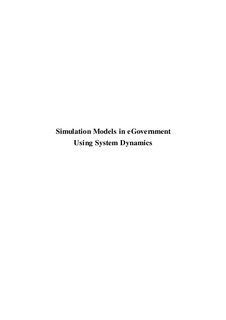| dc.description.abstract | System Dynamics (SD) is a method to build simulation models using computers, to study the behaviour of systems, and apply what-if scenarios aiming at achieving optimal policy design. In this thesis, we are introducing an SD approach in modelling the eGovernment. The thesis is based on two topics or essays: eParticipation and eAccessibility as examples of eGovernment areas that SD models have not been used in before, to show how SD can be used in modelling and supporting decisions in the field of eGovernment, especially in new areas. Although this research is part of the eGovMon project1 where the use of SD method is indicated, via a literature review we shed light on the mathematical modelling methods commonly used in the eGovernment field, and a comparison between the suitable methods and SD is sketched showing the benefits of and our rationale behind choosing SD.
eParticipation aims at linking ordinary people with politics and politicians by making the policymaking process understandable and easy to follow via Information and Communication Technologies. To apply this concept, we were interested in finding a topic of public interest that needs to be highlighted and promoted. Employment policies for Persons with Disabilities (PWD)2 including factors that prevent or promote them to move from welfare recipients to join the labour force in Norway, is such a topic. The employment rate for PWD in Norway is unchanged since 2000, and is not as high as the neighbouring countries, despite the repeated governmental promises. Under this topic, we have administered two questionnaires, one of them towards PWD and another towards potential employers.
The PWD questionnaire covered PWD attitudes towards employment in Norway, including information about the factors enabling them to work, encouraging them to take available work opportunities, and preventing them from active job application. Corre-spondingly, the second questionnaire covered the attitudes of employers towards recruiting PWD in Norway, including factors encouraging employers to, and preventing them from recruiting PWD, as well as information related to employers’ awareness of facts about PWD employment. The results were incorporated in an SD model which focuses on enabling PWD to move from welfare to work. The model is intended to be used by policymakers, disability organisations, and individual citizens, and support more targeted discussions among them.
Additionally, this model was encapsulated in an Interactive Learning Environment (ILE). To explore how the model could change how its users think and take decisions, the ILE was assessed by an expert opinion poll, and tested with users in two different experiments. 67% of the sample of our expert opinion poll thinks that the ILE achieves its intended goals. Furthermore, 71% of the candidates of both experiments have redefined certain knowledge as a result of using the ILE.
eAccessibility of a website refers to the ability of all people to use this website irrespective of their disabilities or the client devices they use to access the Internet. It is an important aspect of websites in general and of public websites in particular. Access to public websites is crucial to assure equal opportunities for all citizens to participate in the society. The government exerts efforts to enhance accessibility, yet there is still room for improvement. Many ways could be proposed to enhance accessibility. However, the impact of selected actions is hard to predict due to diversification and contra-diction, in addition to the continuous change of the system over time.
Under this topic, we have analysed questionnaires collected via a couple of surveys on eGovernment measurement methods, in addition to administering another questionnaire and a sample of webpages to classify the Norwegian municipal website accessi-bility failures according to their original causes. Moreover, we have conducted a set of personal interviews with representatives from municipalities. The findings including factors affecting the accessibility of the municipal websites were compiled into an SD model, which is intended to support policymakers’ and website managers’ decisions, and to enhance their mental models. This SD model was also encapsulated in an ILE, which was used in an experiment with users. Results show that 80% of the experiment candidates have redefined certain knowledge as a result of using this ILE. | nb_NO |
